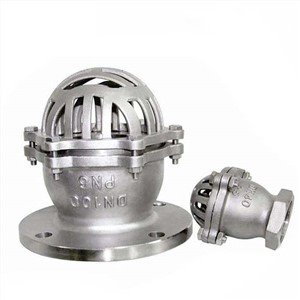A foot valve is a very widely demanded pipe valve, which is applicable in various industries.
Foot Valves are a form of check valve, installed at the bottom of the Pump suction line, inside the wet well. Foot valves are an inexpensive way to prime a single centrifugal pump. Since Foot Valves are continually submerged in the wet well and not readily accessible for inspection or repair, it is important to select a Foot Valve of high-quality long-wearing construction. Typical materials include PVC or plastic and bronze for foot valves.
What is a Foot Valve?
A foot valve is a special type of non-return valve, with a strainer affixed to the open end. For suction lift applications, foot valves are widely used in the pump suction or at the bottom of pipelines. The use of foot valves, keeps the pump primed, the fluid flows in but does not flow back out, and hence they are ideal for wells, ponds, and pools. As the flow area of the foot valves is larger than the pipe size, there is very less head loss.
Foot valve, also called bottom valve, belongs to a type of check valve. Different from other valves, a foot valve has a larger flow area than the pipe size, which is to prevent head loss of the pipe.

Types of Foot valves
Poppet Lift Foot Valve
The poppet assembly consists of a plastic tripod that can be displaced along a bore above the seat valve. The travel of the poppet is controlled by a stop on the end of the poppet legs acting as supports for the return spring shouldered onto a washer. This spring ensures that the valve will work in any position. The main characteristics of this design are low head losses with good sealing provided by a nitrile rubber 0-ring.
Ball Foot Valves
This is a simple ball valve guided by an inclined cylindrical chamber and seating on an O-ring. The ball is displaced laterally along its chamber with the inward flow, but it runs down the chamber onto its seat when the flow rate decreases. [t is particularly suitable for use with contaminated waters or more viscous fluids.
Membrane Foot Valves
Membrane foot valves consist of a cylindrical rubber membrane fitted inside a steel strainer. When there is a suction developed at the strainer, the membrane is displaced to allow fluid to flow through the valve. When back-flow conditions exist, the cylindrical membrane closes the apertures in the valve strainer, thus closing the valve,
Installation of Foot Valves
It is typically installed at a pump or at the end of a pipe. Thus it normally has one end connected to the pipe. And that’s why we call it foot valve. It can help the pump stay primed by letting liquid in and keeping the fluid from flowing backward. The screen or basket of the foot valve stops particles from entering the pipeline.
Most foot valves are designed with a flanged end connected to the pipe, a disc, a seal, and a screen.
Working Principle of Foot Valves
Foot valves being unidirectional allow the flow only in one direction and the valve closes for reverse flow. The inlet strainer of the foot valve filters out the unnecessary solid particles from the fluid and thus prevents valve damage.
When pumps are used to move fluids from lower to higher elevations, a lot of energy will be required. At the same time when the pump is turned off, the liquid will flow back to the lower level. But the use of foot valves prevents this reverse flow. The foot valve maintains the liquid column even when the pump is not working.
Foot valves are basically a type of check valve that prevents the backflow of liquid. They are placed in the pick-up end of the pipe and are located at the very bottom. When the pump is started, a suction is created which opens the foot valve. Water or other liquid easily enters the pipe through the foot valve due to the pulling force of the pump. But when the pump is turned off, this pulling force is removed but still, the water level retains its level as the foot valve does not allow the water to flow back. thus the pump remains always primed.
Material Used for Foot Valves
- Brass
- Plastic
- Aluminum
- Stainless Steel
- Carbon steel
- Cast iron
- Copper
- Nickel
- Rubber etc.
Related Tags :
Ten articles before and after
The relation between Valve Size and Medium Flow Velocity – Zeco |API Approved Valve Supplier
Brief introduction of V-TYPE BALL VALVE – Zeco |API Approved Valve Supplier
Zeco Valves in ECO FUEL INNOVATION PROJECT – Zeco |API Approved Valve Supplier
Precautions for pressure testing of a Plug Valve – Zeco |API Approved Valve Supplier
Opening of Zeco INTEGRATION CENTER – Zeco |API Approved Valve Supplier
Valves fire resistance test – Zeco |API Approved Valve Supplier
Features of Ball Valve – Zeco |API Approved Valve Supplier
Five types of the valve sealing – Zeco |API Approved Valve Supplier












